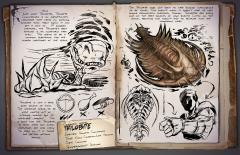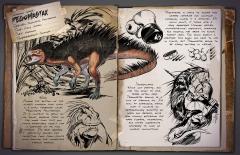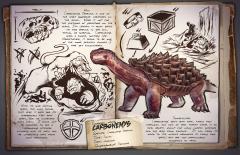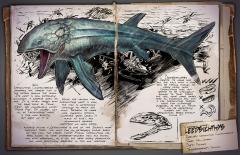Search the Community
Showing results for tags 'defensive'.
-
The Minmi is a well armored "Battle Buddy" useable all the way to end game with a large health pool, Natural armor plating that gets better with use, and can be EQUIPED in your Shield slot OR on your shoulder for different defensive abilities and bonuses! Please forgive my spelling and grammar. Its adorable and tough as nails, the armor plating on its back is as strong as steel! With the proper training this little guy will make BIG changes to Shoulder Pet usage. Carful though, The Minmi is Heavy and Not much of a fighter on its own. Minmi's can easily be 300lbs! making them kind of slow moving similar to its Ankylosaurus Cousins. They live off a hefty diet of fruits, berries, and veggies that grow close to the ground. Eating about it's body weight a day! Needing to stay near the food and enjoying the sounds of water, you'll find the youngest of them in the greenest zones. With that said the Minmi is a solitary creature, Minmi's are hatched and cared for till they can walk, then just kind of wonder off on their own. This is possible because of the armor plating growing and hardening very quickly, replacing damaged plates just as quick explaining the large food intake it needs. Minmi's will wonder from a zone that over supplies their needs compared to the amount of damage they take regularly, meaning Minmi's can be found Migrating out into Badlands and into alternate Hot and Cold lands for a new place to call home. Taming Minmi's takes time, trust, and Grown Fruits and Veggies. Providing it with different types till you find its favorite! The individual Minmi will do the "Petted" animation after eating the food it wants to be fed, continuing to feed it this fruit or veggie is the 1st step to getting a 100% bond! The other thing is so easy its hard to NOT allow happen. All Minmi's will wanna show you what they can do, after finding out its favored food, it will let out a taunting call to near by wild creatures and go into a defensive stands, while its getting attacked you capitalize on the distraction and backstab the assaulting creatures! This will impressing the Minmi and it will want to be fed again to prepare for another call! Eventually the Minmi will decide your its Partner and stay by your side no matter what! Carrying the Minmi is a cumbersome load to haul around BUT worth the carry weight, A Minmi on your shoulder will provide you with a defense buff, however if you pet it 1st the buff is spread to friendly tames and tribe members around you as a limited effect that continues for a time after words. With the Minmi on your shoulder you can launch it forward like a bowling ball, it will travel a ways based on your damage stat and damage enemies in its path! once it comes to a stop it will let out a Taunting call and take a defensive stands, acting as a distraction to enemy tames and wildlife. After the attack stop it will exit defensive stands and (if following you) run back to you to be picked up again. Wielding the Minmi on your forearm (shield slot) it wraps its 4 legs around your arm and holds on tight! Allowing you to use your Minmi as a shield that can out last a steel shield! Running is slowed when holding your Minmi this way but the speed decrease can easily be nullified by a high speed stat or by jumping on a mount to get where your going. The Minmi will take damage when wielded like this from your attackers, Blocking you entirely, and your Minmi gets another similarity from its Anky cousins... Its tail, while not much of a club or any real strength to swing it with, they let the attacks do the work for them. When used as a shield the Minmi Damages the attacker for a % of the attackers damage stat as blow back damage! If you and your Minmi can hold out long enough its possible the unrelenting attackers maybe be their own undoing!! The Minmi is Knockback resistant to large creatures and immune to medium creatures and smaller. This knockback resistance/immunity is something you too benefit from when the Minmi is on your person, shoulder or arm. However the Minmi, when in its Solo Defensive Stands, has its Knockback resistance increased by double against large creatures, which is impossible for a player to benefit from. https://en.wikipedia.org/wiki/Minmi_paravertebra#Discovery_and_species IDK what I'm doing, I'm just a guy who had an idea and seen a dino to partner it with. I'm passionate about this submission and welcome constructive criticism. The Tames focus on Defense is NOT something I'm willing to change course on. I'm no artist so none of these pictures are mine and the one I barrowed from IRONHIDE456 I scribbled on but really loved the art. QuesoTheCheese and Nickevon also submitted Minmi posts in the past
-
HELLO SURVIVORS! ❤️ I have decided to submit a creation / idea of my own and I hope you all enjoy. Since the creature vote is based on "The Center" I thought it fitting to create an aquatic based creature that can also travel on land as there is a lot of ocean on The Center. And before you say it, I know I know, "another giga like creature". but in my defence we have 2 land gigas, 1 sky giga but nothing really for the ocean that matches that strength. And we all know Wild Card can change this idea as they see fit and make it a basic creature if that is their vision. WARNING - I did my best to check spelling and stuff but I am dyslexic so take it easy on me -------------------------- Name - Confractosuchus Sauroktonos Period - Cretaceous Diet - Carnivore Temperament - Agressive -------------------------- INFO The Confractosuchus Sauroktonos or "Sauroktonos / Saurok for short" Was discovered in Australia in the mid 90's and named in 2006 and was found to be severely dismembered and broken so constructing the exact physical appearance was basically impossible. The fact that the fossils were found to be so broken and missing, as well as having a meal in its stomach, lead to its naming Confractosuchus sauroktonos or "Broken Dinosaur Killer". It was said to belong to an undiscovered species of giant crocodile and the fossils found were that of a juvenile but still extremely large. Since little is known of how this giant croc may have looked, I have created my vision of how I would imagine this creature to have looked and I hope you enjoy. --------------------------- Wild Sauroktonos mainly live in the waters as this is where their movement and skills shine as a predator. They spend 90% of their days swimming near the surface and never staying in one area as they have no natural predators that hunt them in the water. They do however have one natural enemy on land, the Giga, and they never pass on an oppertunity to battle it out with their favorite meal. Much like the Spino, the Sauroktonos can live both in the water and on land, but their skills truly shine when faced in the water. They are swift ambush predators when swimming with the ability to snatch larger prey from the shore line back into the ocean in their massive powerful jaws. Some say while experiencing one of these ambush attacks, it is much like a bolt of lightning. One minute everything is peaceful and the next your best dino companion is gone. --------------------------- Domesticated Little is known on how to tame one of these Giga like sea monsters, but survivors have reported that when the Sauroktonos stand against their natural foe and they sense that you have helped them in their victory, they have been known to reward you by bowing their heads and offering a thrilling ride to the depths of the ocean where they can show you their true power. When facing a giga the Sauroktonos's power is unmatched. Those that have tamed these majestic beasts have boasted about the skills the Sauroktonos offer the rider. Some say whilst on the back of the Sauroktonos they suddenly find themselves breathing under water. It's almost as if the Sauroktonos have enveloped them in an air tight bubble secreted from the glands on the back of its neck. It has also been stated that this bubble also protects the rider from external dangers such as electric attacks from eels, and causes all attempts to attack the rider to be repelled such as the attacks from a swarm of dimorphs and even the futile attacks from other survivor weapons. Along with this protection, the Sauroktonos uses the sensitive fins on its neck to send out pulses under water that soothe or repel most aquatic creatures. On land this is turned into a fierce roar that taunts all nearby creatures into battling with this war hungry serpent, and bolsters the speed and stamina of all allies in the area including itself. And as mentioned before, it has the strength in its jaws to pick up and devour creatures smaller than itself. No survivor has been successful in fashioning a saddle for this creature, but it seems to not be needed as the back of this creature is protected by a layer of razor sharp armor that grows over the years from the depths of the sea. Some say that they have sighted some elder Sauroktonos that have so much coral growth on their back that it becomes its own ecosystem for life and aquatic resources. Any mele attacks against the Sauroktonos have been known to tear the attacker to shreds as the battle wages on. When the Sauroktonos's life is threatened, much like the giga, it enters an enraged state where it lets out a roar none wish to hear again. In this state the Sauroktonos's speed and resistances are unmatched and it becomes a bloodthirsty killer. None are safe while this creature is in this state aside from the bonded rider, not even your own tribe. --------------------------- Abilities Left click - Slow but strong bite attack that has a small chance to weaken the enemy's armor values. Right click - "Under water" - Sends out a pulse that soothe and repel most aggressive creatures. "On Land" - Lets out a fierce roar that taunts creatures in the surrounding area to attack and bolsters the speed and stamina of itself and nearby allies. C - "Under Water" - Rapidly sweeps its tail back and forth gaining a short but quick boost of speed. "On Land" - Performs a short lunge forward, bowing its head and knocking creatures back. X - "Only on Land" - Quickly clamps down on a creature smaller than itself and lifts it off the ground. While doing this it can either do a normal attack to kill the creature or simply walk around with its new pet. CTRL - Oozes a strange liquid from the back of its neck covering the rider for a period of time. This liquid both allows the rider to breathe under water and be protected from attacks due to its thick jelly like form. Passives - Has thick coral like armor covering its back and the top of its head. This armor both makes its resistances to physical damage higher than normal and causes considerable recoil damage to attackers. When below 50% HP it lets out a bone chilling roar that skyrockets its speed and slightly raises its natural defense's. I hope you all enjoy this creation! Let me know your thoughts below as all positive and negative thoughts are appreciated. Remember that Wild Card may change any and all of the creatures abilities if they deem fir to balance the creature for both pvp and pve. Art Credits go to Blue Willow AI Art Bot for original creation. Edited by myself. Original Photo. Had to edit out the wee
- 21 replies
-
- semiaquatic
- large dino
-
(and 4 more)
Tagged with:
-
From the album: Dossiers
Common Name: Trilobite Species: Trilobite Conchadurus Time: Early Cambrian-Late Permian Diet: Carnivore Temperament: Defensive Wild: Like most Trilobites, Trilobite Conchadurus is an opportunistic carnivore that feeds on anything smaller than itself which it can get a hold of. A sluggish creature, the Trilobite's best defense is its incredibly hard shell. This seems to be a common adaption for the slower creatures of the island. Trilobite is not a very good source of food. The creature seems to be made mostly out of internal organs and its defensive carapace. This is good for the Trilobite, as both river and ocean predators are less likely to prey on it if there are better options around. Domesticated: The Trilobite does not seem to have enough intelligence to be tamed. This doesn't mean it doesn't have its uses among resourceful survivors, though. Trilobites are easily one of the best sources of high quality chitin on the island, assuming one doesn't wish to venture into the dangerous caves. Known Information: Trilobite is not a very good source of food. The creature seems to be made mostly out of internal organs and its defensive Carapace. This is good for the Trilobite, as both river and ocean predators are less likely to prey on it if there are better options around. -

lemur Archicebus(Lemur) the vualt breaker
TLDCRABMAN posted a suggestion in Creature submission archive
-
From the album: Dossiers
Common Name: Pegomastax Species: Pegomastax Fructarator Time: Early Jurassic Diet: Herbivore Temperament: Defensive Wild: Among the bottom of the island’s dinosaur food chain is a small herbivore called Pegomastax Fructarator. It is content to spend all day alone, gorging itself on far more food that you might reasonably expect for a creature of its tiny stature. It’s beak appears perfectly evolved for collecting food from plants while avoiding the indigestible fibrous strands. Pegomastax is likely to ignore any nearby creature and continue foraging, unless it is attacked. At which point, it turns into a very aggressive (though rather nonthreatening) opponent, shrieking and wooping far above it’s actual threat level. You would expect a creature this small and weak to live in flocks, but Pegomastax seems to be fairly solitary in nature. Domesticated: While not pretty, and far too small to ride, tribes often keep Pegomastax around as a kind of farming aid. It’s skill at scavenging means that it collects an extraordinary quantity of seeds and berries, while also handily gathering the rare flowers, mushrooms, and other ingredients necessary to cool up unusual conceptions.- 1 comment
-
- pegomastax
- defensive
- (and 8 more)
-
From the album: Dossiers
Common Name: Carbonemys Species: Carbonemys obibimus Time: Danian Diet: Herbivore Temperament: Defensive Wild: Carbonemys obibimus is one of the least aggressive creatures on the island. Were it not for the plethora of predators on the island, I'm certain it would spend its days basking in the sun, eating, or sleeping. Carbonemys leads a simple, solitary life. It seems to be one of the most peaceful animals I have yet encountered. With its slow walking speed, the only things that keep it safe are its surprisingly fast swim speed, and its incredibly thick shell. I would not be surprised to see a Carbonemys withdraw entirely into its shell and be completely safe from most predators. Domesticated: Carbonemys ' swift swim rate, fairly high strength, and lack of real threat makes it an ideal aquatic mount for many coastal survivors who shy away from violence. It can carry its rider to the ocean's resources at a fairly high speed, and are not particularly dangerous to tame.-
- carbonemys
- turtle
- (and 6 more)
-
From the album: Dossiers
Common Name: Leedsichthys Species: Leedsichthys Conviviumbrosia Time: Mid-Jurassic Diet: Piscivore Temperament: Defensive Wild: Leedsichthys Conviviumbrosia is probably the largest fish in the waters around the island. Its meant is also extremely succulent, a surprise given its size. It is often traded with the same value as Prime Meat, and colloquially called ‘Prime Fish’. Of course, not all of Leedsichthys’ meat is this high quality but most of it is! While the demand for Leedsichthys meat is high, the fish is notoriously difficult to track and hunt. Between its large size, powerful attacks, incredible speed (when it turns to flee), and humankind’s general ineptitude on open water, actually killing a Leedsichthys is one of the island’s more difficult tasks. The hunt for an extremely elusive breed of the fish, the fabled ‘Great Albino’ Leedsichthys has been known to drive otherwise-sensible men and women mad with obsession, as if all evil were visibly personified and made practically assailable in this one creature. Domesticated: Despite its large size, and the fact that it may well be strong enough to carry heavy loads, Leedsichthys does not appear to be intelligent enough to tame. Nevertheless, some large tribes keep an enormous pen with a few Leedsichthys trapped inside for cultivating purposes, as bits of prime fish can be repeatedly scraped off the gargantuan beast without killing it.-
- leedsichthys
- fish
- (and 7 more)
-
From the album: Dossiers
Common Name: Manta Species: Manta Mobula Time: Early Oligocene - Holocene Diet: Carnivore Temperament: Defensive Wild: Here is another example of a creature that seems to have evolved beyond its historical traits. Everything points to this being a saltwater ray, but Manta Mobula has developed the ability to swim into the island´s rivers and shallows, as well as through the open ocean. Perhaps there were originally two types of ray on the island before, but years of interbreeding combined their lineage. Normally docile, the Manta Mobula is a carnivore only in that it consumes Plankton. Its tail is incredibly sharp, and can pierce through thick hide and armor with ease. Fortunately, Manta Mobula is usually not aggressive, unless encouraged. Domesticated: While not the fastest swimmer around the island, Manta Mobula is the deadliest of small ocean mounts, and can be ridden bare-back. Tribes who value striking power over speed often keep large schools of Manta to ride. Its capability to briefly leap out of water provides it a showy tactic for avoiding combat as well. A quick jab through the heart onto an unsuspecting survivor can easily take them by surprise. Thusly, many tribes use it as an escort for their slower cargo-carrying swimmers.






